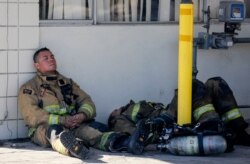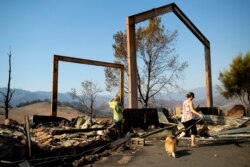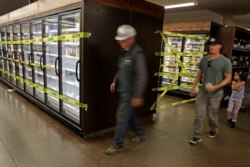Lynn Darst and her husband were camped out in their motor home on the edge of their seats for four days wondering if their house would survive yet another wildfire menacing Sonoma County.
Flames had come close to their neighborhood of spacious homes surrounded by vineyards two years ago and danger was closing in again.
“We were comfortable, but fearful of what the consequences could be,” Darst said Thursday, the day after finding her home had been spared once again.
Darst was among the nearly 200,000 residents allowed to return home even as the fire burned along with several other blazes in the state. They were the lucky ones, at least 140 homes had been destroyed in the Sonoma fire.
The blaze was the largest to burn over a three-week siege of vicious gusts that fanned fast-moving wildfires across California and led utility companies to cut power to millions to prevent winds from blowing branches into electric lines and igniting an inferno.
Calm winds in forecast
The winds subsided in virtually all parts of the state Thursday and forecasters anticipated at least a week of calm weather, though there was no rain in the forecast that would reduce the threat of fall fires.
However, a new wildfire erupted Thursday evening on a ridge north of Los Angeles, where winds continued.
The Ventura County Fired Department said the blaze grew to over a square mile (3 square kilometers) in a couple of hours, prompting evacuations of a few nearby streets and threatening the unincorporated town of Somis, which has about 3,000 residents. Hundreds of firefighters raced to battle the flames.
The most devastating wildfires in California’s history have occurred in the past two years in the fall, fueled by a combination of built-up brush, dry conditions and extreme winds. The anniversary of the deadliest of those — last year’s fire that torched the town of Paradise and killed 85 — is next week.
Less destructive season
The state experienced a wet winter with a large snowpack and temperatures and wind speeds didn’t spike simultaneously over the summer, which has led a less destructive fire season overall.
Acreage burned this year is down nearly 90% from last year and 80% below the five-year average over the same period, according to figures compiled through Sunday by the Department of Forestry and Fire Protection.
The moisture, however, has fueled explosive growth of grasses that have now shriveled into golden and brown tinder.
With virtually no rain in October and bursts of erratic winds, fires sprang up across the state, forcing residents to flee homes at all hours as flames indiscriminately burned barns, sheds, mobile homes and multimillion-dollar mansions.
Conan O’Brien, Arnold Schwarzenegger and LeBron James evacuated hillside estates in Los Angeles while farmworkers were driven from homes in Sonoma County wine country where the fire leveled the historic Soda Rock Winery.
Fires start in many ways
The causes of the fires have been just as diverse.
The blaze that destroyed dozens of trailers in Villa Calimesa Mobile Home Park east of Los Angeles and killed two people was started when a trash truck dumped a flaming load of garbage that spread to grass and was swiftly whipped out of control by winds.
A fire that broke out Thursday in Jurupa Valley, not far from Calimesa, was caused when two of Southern California’s quintessential themes, car chases and Santa Ana winds, collided as a hot car came to a halt in a field and ignited dry grasses.
Power still out in places
Wildfires occurred even as many were in the dark from the intentional outages.
In places where the power stayed on, utility lines and other electrical equipment were suspected or confirmed as the cause of several fires, including the one in Sonoma, another that started on a hillside above the San Fernando Valley of Los Angeles and one that burned around the Ronald Reagan Presidential Library in Simi Valley on Wednesday.
More than 350,000 people statewide remained without power Thursday, most in Southern California where winds were not expected to die until sundown.
Pacific Gas & Electric Co. workers in Northern California were inspecting power lines and working to restore power.
Winds were gusting up to 60 mph (96 kph) early Thursday morning when two fires broke out in the heavily populated inland region east of Los Angeles.
The fire started by the stolen car burned three homes and forced residents to temporarily flee.
Another early morning fire in San Bernardino destroyed six homes and forced about 1,300 people to evacuate, but they were allowed to return home later. The cause was under investigation.
While the fires are not out, progress was heading in the right direction, said Scott Ross, a spokesman for CalFire.
The outcome in Sonoma was better than expected, considering that 80,000 homes had been threatened and evacuations extended to the coast.
“Now it’s just time to get this mopped up and put out,” Ross said.
The fire burned 120 square miles (311 sq. kilometers) and was 60% contained.












